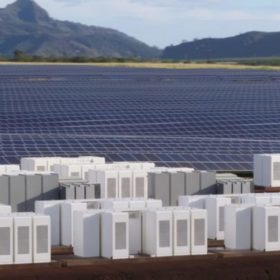From pv magazine USA
Researchers from Stanford University constructed a photovoltaic cell with a thermoelectric generator that harvests energy even in the dark. The solar PV cell has both a hot and a cold side that generates voltage and current from the outgoing heat flow from the solar cell and the surrounding air.
The researchers conducted their work based on the premise that the outgoing heat flow occurs during both day and night, and harvesting that heat could generate power at night. They constructed a device that integrates a PV cell with a thermoelectric generator (TEG) module, and the result is that the solar cell generates power from daytime solar radiation while the TEG generates power from radiative cooling during nighttime. An added benefit is that it generates extra daytime power from solar heating of the PV cell.

Image: Sid Assawaworrarit
“You want the thermoelectric to have very good contact with both the cold side, which is the solar cell, and the hot side, which is the ambient environment,” said author Sid Assawaworrarit. “If you don’t have that, you’re not going to get much power out of it.”
The team demonstrated not only that it can generate power from the device at night, bu that during the day, it runs in reverse and contributes additional power to the conventional solar cell. They achieved 50 mW/m2 nighttime power generation with a clear night sky, with an open-circuit voltage of 100 mV, which is orders of magnitude higher as compared with previous demonstrations, the researchers report.
The setup could be incorporated within existing solar cells. It is simple to construct and uses basic, off-the-shelf components, the researchers say, making it possible to put it together in remote locations.
“The most expensive thing in the whole setup was the thermoelectric itself,” said author Zunaid Omair.
Using electricity at night for lighting requires a few watts of power. The current device generates 50 milliwatts per square meter, which means lighting would require about 20 square meters of photovoltaic area.
“None of these components were specifically engineered for this purpose,” said author Shanhui Fan. “So, I think there’s room for improvement, in the sense that, if one really engineered each of these components for our purpose, I think the performance could be better.”
The next step in their work is to optimize the thermal insulation and thermoelectric components of the device, and they’re looking at improving the solar cell itself to enhance the radiative cooling performance while maintaining its solar energy harvesting capability.
The paper “Nighttime electric power generation at a density of 50mW/m2 via radiative cooling of a photovoltaic cell” is published in Applied Physics Letters, by AIP Publishing,
This content is protected by copyright and may not be reused. If you want to cooperate with us and would like to reuse some of our content, please contact: editors@pv-magazine.com.









By submitting this form you agree to pv magazine using your data for the purposes of publishing your comment.
Your personal data will only be disclosed or otherwise transmitted to third parties for the purposes of spam filtering or if this is necessary for technical maintenance of the website. Any other transfer to third parties will not take place unless this is justified on the basis of applicable data protection regulations or if pv magazine is legally obliged to do so.
You may revoke this consent at any time with effect for the future, in which case your personal data will be deleted immediately. Otherwise, your data will be deleted if pv magazine has processed your request or the purpose of data storage is fulfilled.
Further information on data privacy can be found in our Data Protection Policy.